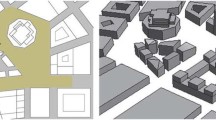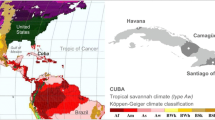Abstract
This study assessed the effect of wind on human thermal comfort by preforming outdoor urban climatic comfort simulations using state-of-the-art heat-balance models of human thermo-physiology (Universal Thermal Climate Index—UTCI). A series of simulations for computing “wind cooling potential” have been performed using the UTCI index temperatures. The comfort cooling effect of wind has been estimated by modelling with wind taken into account, and under calm wind (0.05 m/s) (ΔUTCI). A novel wind rose biometeorological data visualisation tool that integrates an additional thermal comfort dimension into the conventional climatology wind rose visualisation was developed in this study. The new wind rose graphic tool identifies “predominant” wind directions, and whether or not they are “desirable” from the human thermal comfort point of view. This tool’s utility lies in its identification of the optimal building orientation in its surrounding urban morphology, based on the cooling potential of wind resources when enhanced ventilation is desirable for thermal comfort.




Similar content being viewed by others
Notes
Based on the random nature of the wind, the fluctuation in wind direction would typically be ±30° and the wind speed at low mean wind speed (e.g.10 kph) would fluctuate between 0 and 20 kph depending on the averaging duration which from the BoM is typically 10 minutes before the half hour or hour time stamp.
There is no definitive guidance in the literature identifing the air temprature at which the evaporative heat loss derived from elevated air speed becomes outweighed by the convective heat gains from the hot air to the body (see Gagnon et al. 2008), suggesting that more work needs to be done on this question.
Abbreviations
- A:
-
Long wave radiation from the atmosphere (Wh/m2)
- Clo:
-
Clothing insulation worn by building occupants (clo)
- D:
-
Diffuse solar horizontal radiation (Wh/m2)
- e :
-
Vapour pressure (hPa)
- G:
-
Global solar horizontal radiation (Wh/m2)
- r :
-
Moisture (g/kg dry air)
- Met:
-
Human Metabolic rate (W/m2)
- MRT:
-
Mean radiant temperature (°C)
- Ta:
-
Air temperature (°C)
- TMY:
-
Typical Meteorological Year
- UTCI:
-
Universal Thermal Climate Index (°C)
- V :
-
Wind speed (m/s)
- Δ UTCI:
-
Wind cooling potential (°C)
References
ASHRAE-55 (2017) Standard 55-2017. Thermal environmental conditions for human occupancy. ASHRAE, Atlanta
Australian Bureau of Meteorology (BoM) (2017) Wind roses. Retrieved accessed 21/06/2017, from Australian Goverrnment http://www.bom.gov.au/climate/averages/wind/wind_rose.shtml
Batt K (1995) Sea breezes on the NSW coast. O shore Yachting
Blazejczyk K, Epstein Y, Jendritzky G, Staiger H, Tinz B (2012) Comparison of UTCI to selected thermal indices. Int J Biometeorol 56(3):515–535
Boland J (2008) Time series modelling of solar radiation. Modeling Solar Radiation at the Earth’s Surface. Springer, pp 283–312
Boland J, Ridley B, Brown B (2008) Models of diffuse solar radiation. Renew Energy 33(4):575–584. https://doi.org/10.1016/j.renene.2007.04.012
Bröde P, Fiala D, Błażejczyk K, Holmér I, Jendritzky G, Kampmann B, Tinz B, Havenith G (2012) Deriving the operational procedure for the Universal Thermal Climate Index (UTCI). Int J Biometeorol 56(3):481–494
Cabanac M (1971) Physiological role of pleasure. Science 173(4002):1103–1107
CSIRO (2012) Commonwealth Scientific and Industrial Research Organisation. Carbon 6(34):834
De Dear R (2011) Revisiting an old hypothesis of human thermal perception: alliesthesia. Build Res Inf 39(2):108–117
Fanger PO, Melikov AK, Hanzawa H, Ring J (1988) Air turbulence and sensation of draught. Energy Build 12(1):21–39. https://doi.org/10.1016/0378-7788(88)90053-9
Fiala D, Havenith G, Bröde P, Kampmann B, Jendritzky G (2012) UTCI-Fiala multi-node model of human heat transfer and temperature regulation. Int J Biometeorol 56(3):429–441
Gagge AP, Fobelets AP, Berglund L (1986) A standard predictive index of human response to the thermal environment. ASHRAE Trans.;(United States), 92(CONF-8606125-)
Gagnon D, Jay O, Lemire B, Kenny GP (2008) Sex-related differences in evaporative heat loss: the importance of metabolic heat production. Eur J Appl Physiol 104(5):821–829
Givoni B (1976) Man, climate and architecture. Applied science, London
Givoni B (1998) Climate considerations in building and urban design. John Wiley & Sons
Gonzalez RR, Nishi Y, Gagge AP (1974) Experimental evaluation of standard effective temperature a new biometeorological index of man’s thermal discomfort. Int J Biometeorol 18(1):1–15. https://doi.org/10.1007/bf01450660
Google Maps (2018). Retrieved from https://www.google.com.au/maps/. Accessed 07 Aug 2018
Havenith G, Fiala D, Błazejczyk K, Richards M, Bröde P, Holmér I, Rintamaki H, Benshabat Y, Jendritzky G (2012) The UTCI-clothing model. Int J Biometeorol 56(3):461–470
Jendritzky G, de Dear R, Havenith G (2012) UTCI—why another thermal index? Int J Biometeorol 56(3):421–428
Lechner N (2009) Heating, cooling, lighting: sustainable design methods for architects. John Wiley & Sons, Hoboken
Matzarakis A, Rutz F (2010) Application of the RayMan model in urban environments. Meteorological Institute, University of Freiburg, Freiburg
Matzarakis A, Rutz F, Mayer H (2010) Modelling radiation fluxes in simple and complex environments: basics of the RayMan model. Int J Biometeorol 54(2):131–139. https://doi.org/10.1007/s00484-009-0261-0
Ng E, Cheng V (2012) Urban human thermal comfort in hot and humid Hong Kong. Energy Build 55:51–65
Osczevski, R. & Bluestein, M. (2005). The new wind chill equivalent temperature chart, Bulletin of the American Meteorological Society, 86, 1453–1458.
Parkinson T, de Dear R (2015) Thermal pleasure in built environments: physiology of alliesthesia. Build Res Inf 43(3):288–301
Passe U, Battaglia F (2015) Designing spaces for natural ventilation: an architect’s guide. Routledge
Ridley B, Boland J (2002) Generating synthetic typical meteorological years. Australian and New Zealand Solar Energy Society
Roaf S, Hancock M (1992) Energy efficient building: a design Gguide. Blackwell Scientific Publications
Roaf S, Crichton D, Nicol F (2009) Adapting buildings and cities for climate change: a 21st century survival guide. Routledge
Santamouris M (2006) Ventilation for comfort and cooling: the state of the art. Building Ventilation: The State of the Art, 27, 217
Santamouris M, Allard F (1998) Natural ventilation in buildings: a design handbook: Earthscan
Shitzer A, de Dear R (2006) Inconsistencies in the “new” Windchill chart at low wind speeds. J Appl Meteorol Climatol 45:787–790
Watterson I, Whetton P, Moise A, Timbal B, Power S, Arblaster J, McInnes K (2007) Regional climate change projections. Clim Change Aust 148:201–223
Watterson I, Ekstrom M, Whetton P (2015) Rangelands cluster report, climate change in Australia. Projections for Australia natural resource management regions: Cluster Reports: CSIRO and Bureau of Meteorology, Australia
Wilcox S, Marion W (2008) User’s manual for TMY3 data sets, NREL/TP-581-43156. National Renewable Energy Laboratory, Golden Colorado
Acknowledgments
This research project was financially supported by the Centre for Infrastructure Engineering (CIE) at the Western Sydney University (WSU) and the School of Architecture, Design and Planning at the University of Sydney. Authors would like to express their thanks to Dr. Martin Belusko of The University of South Australia for help with Typical Meteorological Year files.
Author information
Authors and Affiliations
Corresponding author
Rights and permissions
About this article
Cite this article
Sadeghi, M., de Dear, R., Wood, G. et al. Development of a bioclimatic wind rose tool for assessment of comfort wind resources in Sydney, Australia for 2013 and 2030. Int J Biometeorol 62, 1963–1972 (2018). https://doi.org/10.1007/s00484-018-1597-0
Received:
Revised:
Accepted:
Published:
Issue Date:
DOI: https://doi.org/10.1007/s00484-018-1597-0




